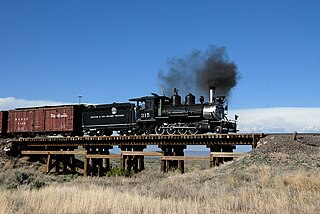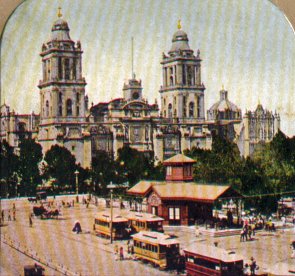
A tram is a train that runs on tramway track on public urban streets; some include segments of segregated right-of-way. The lines or networks operated by tramcars as public transport are called tramways or simply tram/streetcar. Many recently built tramways use the contemporary term light rail. The vehicles are called streetcars or trolleys in North America and trams or tramcars elsewhere. The first two terms are often used interchangeably in the United States, with trolley being preferred in the eastern US and streetcar in Canada and the western US. In parts of the United States, internally powered buses made to resemble a streetcar are often referred to as "trolleys". To avoid further confusion with trolley buses, the American Public Transportation Association (APTA) refers to them as "trolley-replica buses". In the United States, the term tram has sometimes been used for rubber-tired trackless trains, which are unrelated to other kinds of trams.

Conservation and restoration of rail vehicles aims to preserve historic rail vehicles.

A Birney or Birney Safety Car is a type of streetcar that was manufactured in the United States in the 1910s and 1920s. The design was small and light and was intended to be an economical means of providing frequent service at a lower infrastructure and labor cost than conventional streetcars. Production of Birney cars lasted from 1915 until 1930, and more than 6,000 of the original, single-truck version were built. Several different manufacturers built Birney cars. The design was "the first mass-produced standard streetcar " in North America.

A horsecar, horse-drawn tram, horse-drawn streetcar (U.S.), or horse-drawn railway (historical), is an animal-powered tram or streetcar.

The J.G. Brill Company manufactured streetcars, interurban coaches, motor buses, trolleybuses and railroad cars in the United States for almost ninety years, making it the longest-lasting trolley and interurban manufacturer. At its height, Brill was the largest manufacturer of streetcars and interurban cars in the US and produced more streetcars, interurbans and gas-electric cars than any other manufacturer, building more than 45,000 streetcars alone.

The Ottawa Car Company was a builder of streetcars for the Canadian market and was founded in Ottawa, Ontario, in 1891 as an outgrowth of the carriage building operations of William W. Wylie. Its plant was located at Kent and Slater Streets, a short distance from Parliament Hill. The company was a subsidiary of Ottawa Electric Railway, in turn controlled by Ahearn & Soper.

The Denver Tramway, operating in Denver, Colorado, was a streetcar system incorporated in 1886. The tramway was unusual for a number of reasons: the term "tramway" is generally not used in the United States, and it is not known why the company was named as such. The track was 3 ft 6 in narrow gauge, an unusual gauge in the United States, but in general use by railways in Japan, southern Africa, New Zealand, and Queensland, Australia.

Construcciones y Auxiliar de Ferrocarriles is a Spanish publicly listed company which manufactures railway vehicles and equipment and buses through its Solaris Bus & Coach subsidiary. It is based in Beasain, Basque Autonomous Community. Equipment manufactured by Grupo CAF includes light rail vehicles, rapid transit trains, railroad cars and locomotives, as well as variable gauge axles that can be fitted on any existing truck or bogie.
Dick, Kerr and Company was a locomotive and tramcar manufacturer based in Kilmarnock, Scotland and Preston, England.

Streetcars or trolley(car)s were once the chief mode of public transit in hundreds of North American cities and towns. Most of the original urban streetcar systems were either dismantled in the mid-20th century or converted to other modes of operation, such as light rail. Today, only Toronto still operates a streetcar network essentially unchanged in layout and mode of operation.

The Third Avenue Railway System (TARS), founded 1852, was a streetcar system serving the New York City boroughs of Manhattan and the Bronx along with lower Westchester County. For a brief period of time, TARS also operated the Steinway Lines in Long Island City.
The history of trams, streetcars, or trolleys began in the early nineteenth century. It can be divided up into several discrete periods defined by the principal means of motive power used.

The Jewett Car Company was an early 20th-century American industrial company that manufactured streetcars and interurban cars.

Although tram systems date to the late 19th and early 20th centuries, many old systems were closed during the mid-20th century because of the advent of automobile travel. This was especially the case in North America, but postwar reductions and shutdowns also occurred on British, French and other Western European urban rail networks. However, traditional tramway systems survived, and eventually even began to thrive from the late 20th century onward, some eventually operating as much as when they were first built over a century ago. Their numbers have been augmented by modern tramway or light rail systems in cities which had discarded this form of transport.
The Omaha and Council Bluffs Railway and Bridge Company, known as O&CB, was incorporated in 1886 in order to connect Omaha, Nebraska with Council Bluffs, Iowa over the Missouri River. With a sanctioned monopoly over streetcar service in the two cities, the O&CB was among the earliest major electric street railway systems in the nation, and was one of the last streetcar operators in the U.S., making its last run in 1955.

John G. Stephenson, an American coachbuilder, invented and patented the first streetcar to run on rails in the United States. Stephenson also designed the New York and Harlem Railroad which was formally opened on 26 November 1832. Twelve days later a horse-drawn streetcar built at Stephenson's works and named John Mason after the president of the railroad company, started the public service. Stephenson is therefore remembered as the creator of the tramway. Stephenson was the great-grandfather of Alan Stephenson Boyd, the first United States Secretary of Transportation.

Servicio de Transportes Eléctricos de la Ciudad de México (STE) is a public transport agency responsible for the operation of all trolleybus and light rail services in Mexico City. As its name implies, its routes use only electrically powered vehicles. It was created on 31 December 1946 and is owned by the Mexico City government. STE is overseen by a broader Federal District authority, Secretaría de Transportes y Vialidad, which also regulates the city's other public transport authorities, including Sistema de Transporte Colectivo, Red de Transporte de Pasajeros del Distrito Federal and Metrobús, as well as other forms of transportation in the district. STE's passenger vehicle fleet consists exclusively of trolleybuses, light rail, and aerial lift vehicles, and in 2007 its network carried 88 million passengers, of which 67 million were on trolleybus services and 21 million on light rail.

Mexico City once had an extensive network of streetcars. Most streetcar lines in Mexico City radiated from the city's central square, the Zócalo towards many parts of the city. By the 1980s only one streetcar line survived, which itself was converted into the Xochimilco Light Rail line in 1986.

The tranvía was a streetcar system that served Manila and its surrounding cities during the early years of the 20th century.


















